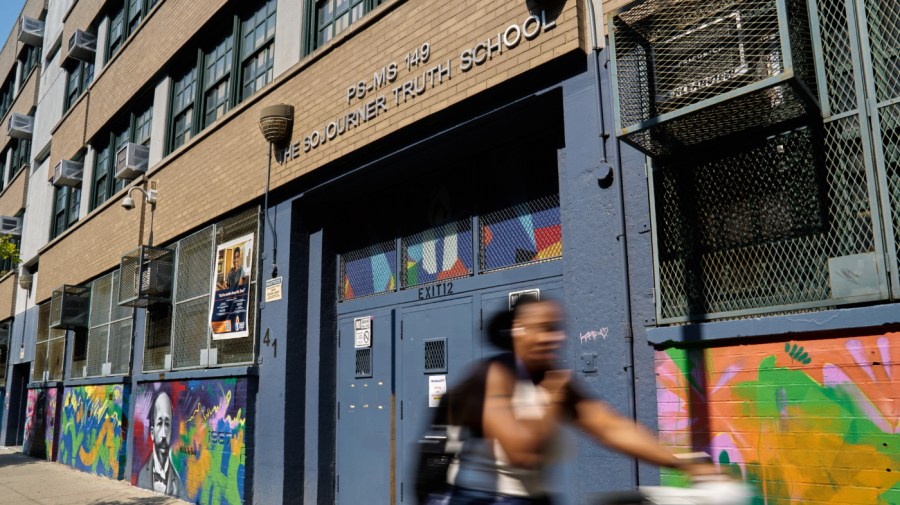
In the churning chaos of the last few weeks, it’s understandable that many didn’t read closely the executive order on school choice that President Trump signed last month. But those who care about equality in our public schools might be surprised to see what the order says.
“Geographically based school assignments,” the order states in the very first paragraph,“ exacerbate the cost of housing in districts with preferred schools, straining the finances of millions of American families sacrificing for their children’s futures.”
Everyone knows it to be true, but we rarely talk about it: Geographic assignment forces American families to “pay” for access to local public schools via their mortgages. Middle-income and working-class families are often boxed out of coveted public schools because they can’t afford to live in those neighborhoods. And, yes, it drives up the cost of housing.
This echoes the redlining era of American history, when certain neighborhoods were designated as ineligible for federal housing assistance because of a high concentration of non-white residents. Indeed, the attendance zone maps of many elite public schools actually mirror the patterns on the racist redlining maps from the 1930s.
In many cities, it’s common for families to pay an extra $300,000 or more for a home in a coveted school zone. This is often the true cost of a “free” public education, and it affects all of us.
Do you know anyone who has lied about their address to get their child into one of these schools? Have you navigated the Kafkaesque paperwork of your district’s magnet process, because your child was zoned to a failing public school? Or perhaps but you were outbid for a home because someone else wanted access to the zoned school that came with the house — and maybe you don’t even have school-aged children.
Ending geographic assignment has long been a goal of the political left. “School district lines,” said Justice Thurgood Marshall, “however innocently drawn, will surely be perceived as fences to separate the races.” Progressive thinkers like Matt Yglesias, Nikole Hannah-Jones and Kevin Carey have all decried the exclusionary effects of school boundaries.
Why, then, is President Trump challenging geographic assignment? As with so many other areas of American life, the politics of education reform have been scrambled in recent years.
There are still many on the left who call out educational redlining, including brave groups like Brown’s Promise, which urges an end to “school gerrymandering.” But district executives and union leaders — those that control the K-12 schools — have generally opposed more open enrollment policies. The National Education Association touts its success in defeating open enrollment at the state level. It has even gone so far as to claim that more choices — even public choices — will lead to more segregation.
But that doesn’t make sense. Nearly 80 percent of public school students attend their zoned public school. So it is geographic assignment that keeps our schools divided along racial and economic lines. If the government somehow banned all other options and sent every single child back to his or her zoned school, our schools would still be horribly racially divided.
The good news is that there are common-sense reforms that can ease the strict residential assignment system. Open enrollment should be universal: Any public school with space available should be required to accept students from outside the zone. Also, schools that are full should be required to reserve a certain percentage of seats — perhaps 15 percent — for children who live outside the zone boundaries.
Such a measure would protect the local nature of individual schools but also relax the strict residency requirements that have been so harmful to our social contract.
Public schools should be required to take applications from any student. If a school turns them away, it should have to issue a formal letter specifying a legal justification. Families should have the right to appeal an enrollment denial, as they already do in California and Arkansas.
Now is the time. If you believe, as Democratic strategist Ruy Teixeira has argued, that Democrats should be working with Trump “when he is right,” then this is a prime example of where the two parties can work together on practical solutions. On the other hand, if you see Trump as irredeemable and only trying to score political points, then it’s time to call his bluff.
Either way, Americans of goodwill on the left and the right may finally be ready to move on from strict geographical assignment. All our kids deserve a fighting chance to get into a high-quality public school.
Tim DeRoche is the founder and president of Available to All, a nonpartisan watchdog that defends equal access to public schools. He is the author of “A Fine Line: How Most American Kids Are Kept Out of the Best Public Schools.”












